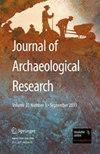西墨西哥可可豆的历史:对中美洲和美国西南部联系的启示
IF 4.1
1区 历史学
Q1 ANTHROPOLOGY
引用次数: 24
摘要
墨西哥西部的可可经济在公元850/900年到1350年之间发展起来,同时,随着Aztatlán文化融入到中美洲高地和南部不断扩大的政治、经济和信息网络中,以太阳神Xochipilli为中心的政治-宗教综合体被采用。Xochipilli建筑群极大地改变了Aztatlán纳亚里特和锡那罗亚沿海核心区以及哈利斯科州、杜兰戈、萨卡特卡斯和Michoacán部分地区的社会。西墨西哥可可在美国西南部被新墨西哥州查科峡谷的精英们通过宏观区域声望商品经济获得,因为祖先普韦布洛社会融入了后古典中美洲世界。本文章由计算机程序翻译,如有差异,请以英文原文为准。
A History of Cacao in West Mexico: Implications for Mesoamerica and U.S. Southwest Connections
Cacao economies in far western Mexico developed between AD 850/900 and 1350+ along with the adoption of a political–religious complex centered on the solar deity Xochipilli as the Aztatlán culture became integrated into expanding political, economic, and information networks of highland and southern Mesoamerica. The Xochipilli complex significantly transformed societies in the Aztatlán core zone of coastal Nayarit and Sinaloa and parts of Jalisco, Durango, Zacatecas, and Michoacán. West Mexican cacao was acquired in the U.S. Southwest by Chaco Canyon elites in New Mexico through macroregional prestige goods economies as Ancestral Pueblo societies became integrated into the Postclassic Mesoamerican world.
求助全文
通过发布文献求助,成功后即可免费获取论文全文。
去求助
来源期刊

Journal of Archaeological Research
Multiple-
CiteScore
10.20
自引率
7.90%
发文量
9
期刊介绍:
Journal of Archaeological Research publishes the most recent international research summaries on a broad range of topics and geographical areas. The articles are intended to present the current state-of-the-discipline in regard to a particular geographic area or specific research topic or theme. This authoritative review journal improves access to the growing body of information and literature through the publication of original critical articles, each in a 25-40 page format.2-Year Impact Factor: 4.056 (2017) 5-Year Impact Factor: 4.512 (2017)2 out of 85 on the Anthropology listIncluded in the European Reference Index for the Humanities (ERIH) PLUS The European Reference Index for the Humanities and the Social Sciences (ERIH PLUS) was created and developed by European researchers under the coordination of the Standing Committee for the Humanities (SCH) of the European Science Foundation (ESF). https://dbh.nsd.uib.no/publiseringskanaler/erihplus/about/indexSCImago Journal and Country Rank (SJR) 2018: 1.7102 out of 263 on the Archeology (Arts and Humanities) list3 out of 254 on the Archeology list2 out of 131 on the General Arts and Humanities listSJR is a measure of the journal’s relative impact in its field, based on its number of citations and number of articles per publication year.Source Normalised Impact per Paper (SNIP) 2018: 2.112The SNIP measures contextual citation impact by weighting citations based on the total number of citations in a subject field. The impact of a single citation is given higher value in subject areas where citations are less likely, and vice versa.CiteScore 2018: 3.86Rated ''A'' in the Australian Research Council Humanities and Creative Arts Journal List. For more information, visit: http://www.arc.gov.au/era/journal_list.htm
SCImago Journal and Country Rank (SJR) 2011 1.227 Archeology 1 out of 96 Archeology (Arts and Humanities) 1 out of 59 Arts and Humanities (miscellaneous) 1 out of 243
 求助内容:
求助内容: 应助结果提醒方式:
应助结果提醒方式:


